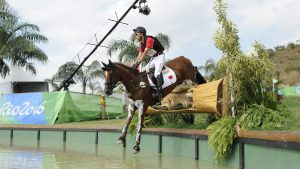Event Leg Grease on Cross Country
You may have seen Eventing at the Olympics or World Championships and watched athletes from many nations competing at the highest level around tough cross-country tracks. Some of their horses appear to have white foam down the front of all four legs, or maybe just on the front of their hind legs, but is it foam from sweat?? Or is it something else?

The white substance seen above is eventing grease, placed on the legs to help the horse ‘slide’ over any solid fences out on cross country. It is a personal preference for each rider if they use grease and where, why and how they like to apply it. There are many different ways grease can be utilized:
- Down the front of all four legs, from chest to fetlock on the front legs, and stifle to fetlock on the hind legs
- Just on the front legs, from the forearm to below the knee
- Just on the stifles and gaskins of the hind legs
- It is also possible to place some on the back of the knees to help slide down a tall drop or a fence into water.
There are a couple of things to think about when you are deciding whether to apply grease before your cross-country round:
- Am I doing a level where I am worried that my horse will be hitting fences, either because of the size or my horse’s experience?
- Are there many fences on the course where there are solid fences that don’t involve brush or frangible devices?
- If I apply too much grease, am I restricting my horse’s ability to cool down? A layer of grease will trap heat within the horse as the sweat is not able to permeate through the grease.
- Is my horse likely to get tired towards the end of the course and start hitting fences, or leaving legs on the fence at take-off?
Most professional riders do not begin to use grease on their horses until they reach the higher levels of the sport and are competing at a three-day event where the cross-country course is longer and the physical demands of the course may take their toll. It is important that if you are deciding to apply grease, that you don’t apply it too early. It’s best applied prior to tackling your final warm-up fences and applied by someone on the ground, in safe manner that won’t get them or you hurt if your horse kicks out. Remember to keep your reins and stirrups away from the grease – no one wants slippery reins or greasy stirrup irons!

Safety measures that may negate the need for eventing grease include MIM Clips and Frangible Pins. These innovations are designed to make the fence collapse if hit hard enough by a horse, which may prevent a serious rotational fall. With more and more fences utilizing this technology, there may come a time when grease is not necessary. But as with everything equestrian, it is up to the rider to decide what is best for them and their horse!
Written by Emma H.
Experts in Equine Nutrition
Every product in the Ranvet range has been developed to meet a horse’s most specific need at any given time, be it in a training environment or on a breeding farm. Having pioneered the formulation of specific medications and dietary supplements for horses, the company is now recognised as a leader in the areas of equine health and nutrition.
